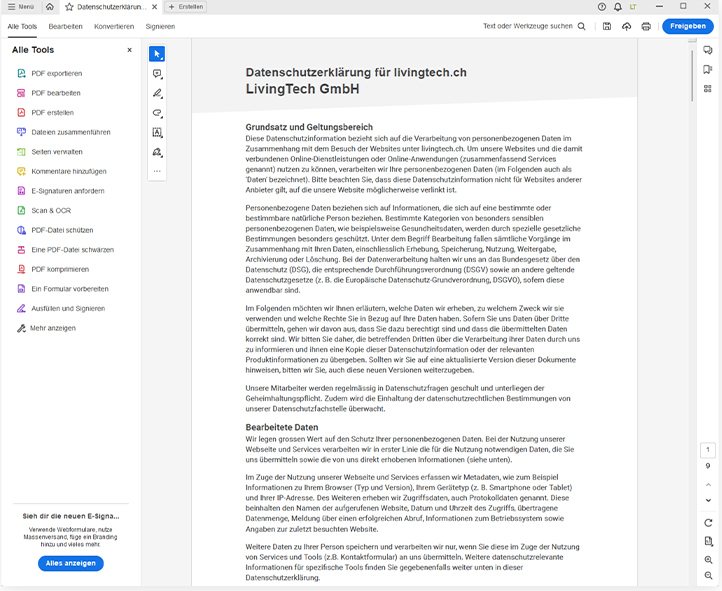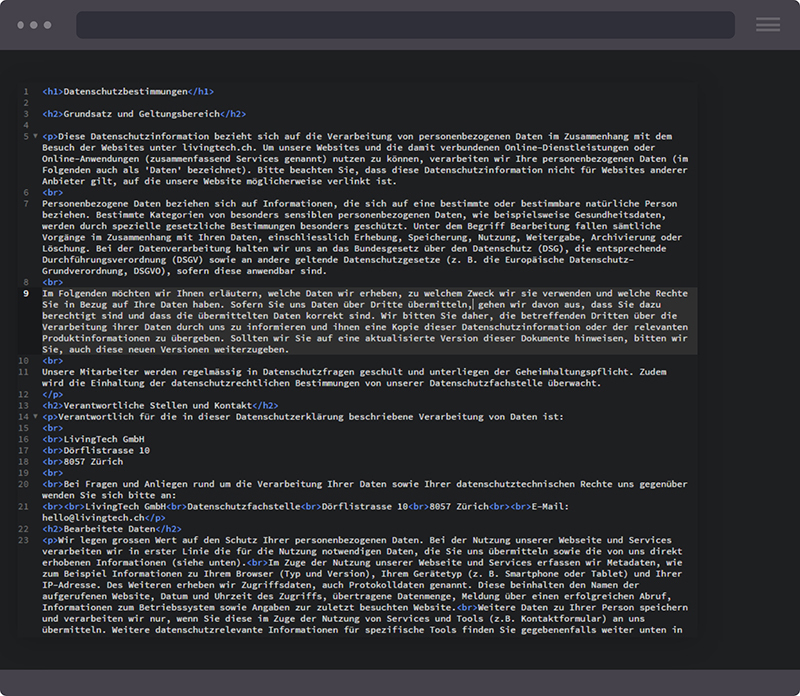Privacy policy for your homepage
Data protection generator for Swiss websites - Create data protection declaration
The new Swiss Data Protection Act has been in force since September 1, 2023 and requires all website operators to publish a privacy policy. Avoid problems and fines and let our generator create your individual privacy policy for your website.
Create a privacy policy for your website quickly and easily with our data protection generator. In accordance with the new Swiss Data Protection Act, of course. Inform your website visitors in a clear way how you process data and where it is stored.
Create a privacy policy for your website
LivingTech's Privacy Policy Generator allows you to create privacy policies that reflect your individual situation. Regardless of whether you operate a private website or a company website, our generator takes your specific requirements into account and supplements them with general texts.
We ask you simple and understandable questions about your website and generate a customized privacy policy. In just a few minutes, you will receive a PDF file and an HTML file to integrate into your website.
Wer sollte diesen Datenschutz Generator benutzen? Schweizer Firmen, Private, Stiftungen und Vereine, die eine Website betreiben, die sich vorwiegend an Schweizer Kundschaft richtet. Unser Generator richtet sich nach dem Schweizer DSG.
Privacy policy for your website
CHF 69
one-time
Your individual privacy policy
For Swiss companies, associations and private individuals
No recurring costs
Payment by invoice or credit card
Immediately available as PDF and HTML after completing the order
Our offer includes
Privacy policy for your website as PDF
Our data protection generator creates your individual privacy policy and automatically generates a PDF.


Privacy policy as HTML code
Our data protection generator creates the data protection declaration as ready-made HTML code that you can easily integrate into your website.
What does a data protection declaration according to the new Data Protection Act consist of?
Visitors must now be informed transparently and as simply as possible about how their data is processed. This can be done in different ways. We recommend including a link to the privacy policy in the footer of the website. Alternatively, the data protection provisions could also be integrated into the company's general terms and conditions. Previously, only companies that processed particularly sensitive information (religion, political orientation, biometric data, etc.) were required to display data protection provisions. Now, all companies that process data must also declare this; this was decided with the expansion of the information obligation in the new law. It must also be clear which data is passed on to third parties for processing. Users must also be informed of how they can exercise their rights with regard to the data they have stored.
Who is responsible for data processing?
What personal data is collected?
How long will the data be stored?
How can users exercise their rights?
What data is passed on to third parties and for what purpose?
Why and for what purpose is the collected data processed?
Which contact details can be used to ask questions about data protection?
Does the user have the option of deactivating the collection of data (cookie consent)?
These recommendations are also in line with the recommendations of the Federal Data Protection and Information Commissioner (FDPIC).
We are of the opinion that only services that directly affect the website should be listed in the data protection provisions published on a website. For example, is a contact form used and how is the data processed? Does the website have a blog with a comment function? In our view, further provisions, such as with which cloud provider and with which security precautions contracts are stored, do not belong in the privacy policy on the website, as this has nothing directly to do with the visit to the website and can be communicated to the customer at a later date, e.g. when a contract is concluded.
